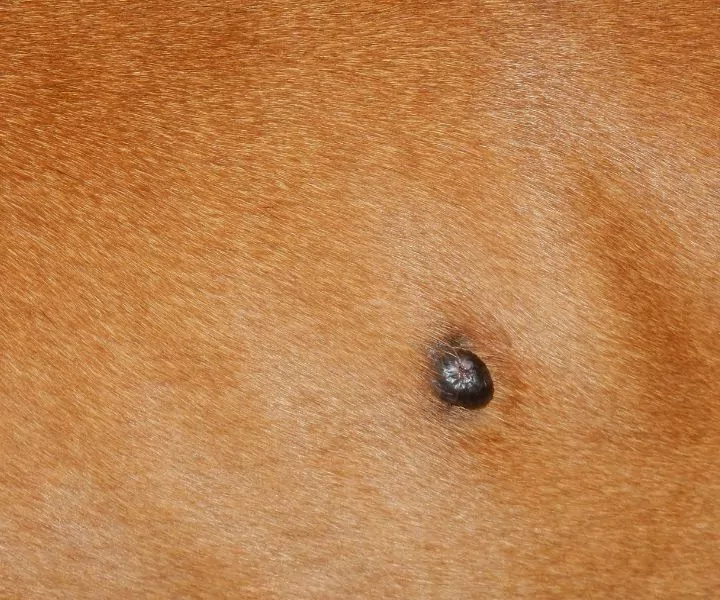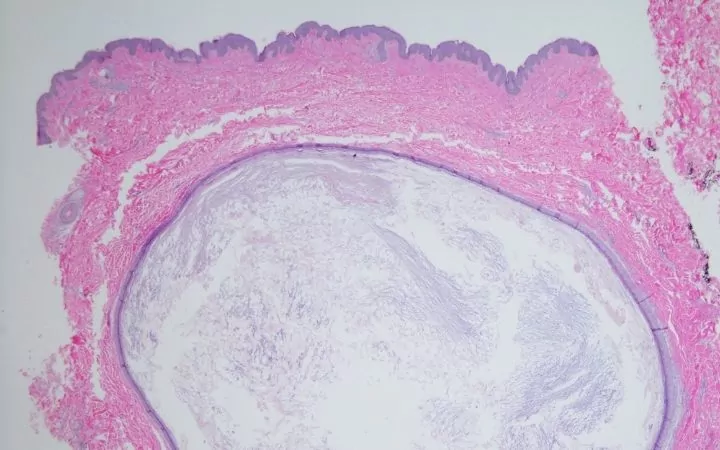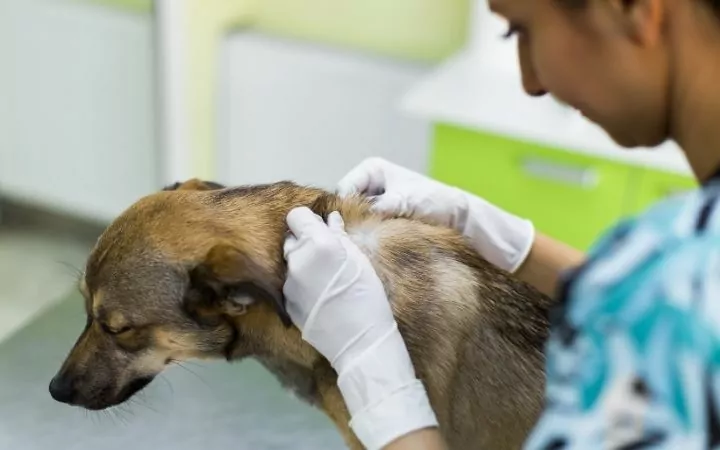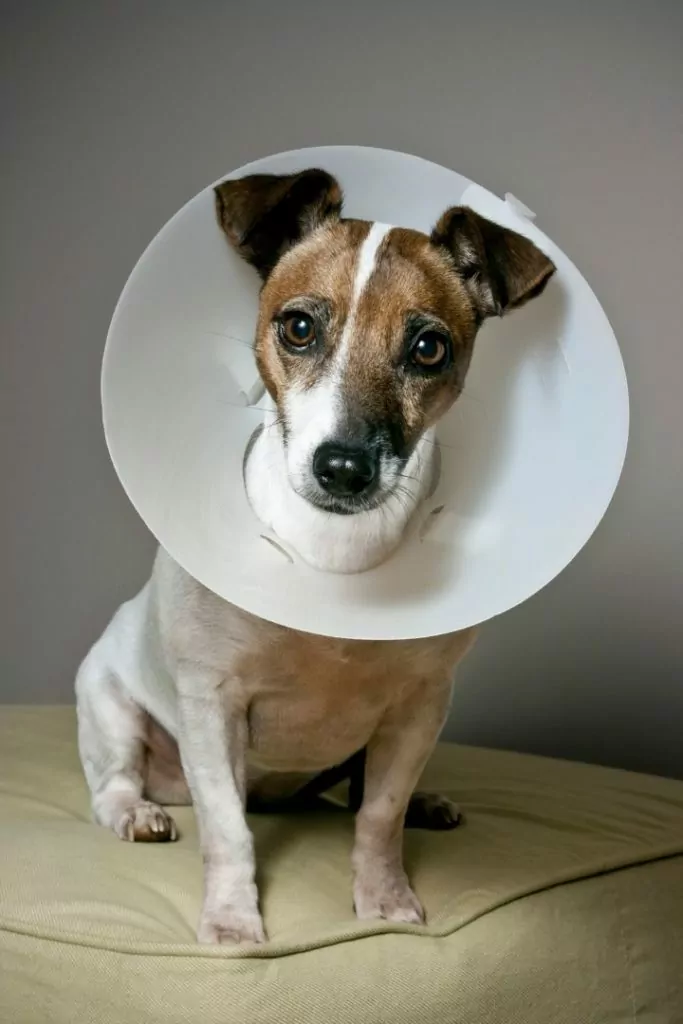What are sebaceous cysts on dogs? When you pet your dog, you often feel their silky fur, cute wet nose, and sometimes a few bumps. Because you’re not sure what it is, you find yourself inspecting it closer. The size, shape, location are all noted. But, what is this small, raised bump?
This bump can be many things, but luckily after contacting your veterinarian and making an appointment, you discover it is a sebaceous dog cyst. You’re calm at last as they assure you a dog sebaceous cyst is nothing to worry about. But, what exactly is a dermal cyst on a dog?
Read on to find out!

What Classifies as a Sebaceous Cyst on a Dog?
First, let’s discuss what a cyst is. Cysts are abnormal growths that are sometimes filled with liquid or a semisolid substance. The contents inside can range from sebum (an oily, waxy substance secreted by sebaceous glands), sweat or dead cells.
Your dog has sebaceous glands, which are glands in the skin that open into a hair follicle and secrets sebum. The sebum is necessary to lubricate the hair. Sebaceous cysts form when the oil gland or duct (the opening through which the oil travels through) gets blocked and becomes clogged and forms a dog pimple.
The Types of Canine Cysts
There are many different types of cysts that dogs get besides sebaceous cysts. They are listed below:
- True cysts– True cysts have a membrane that lines the inner surface and produces secretions. They often need to be removed to prevent them from growing or recurring.
- Dermoid cysts– Dermoid cysts are cysts that contain mature, solid tissues. It usually consists of hair follicles, sweat glands, or skin. They are generally rare and often benign, and dogs are born with them. This term is also called congenital for short.
- Follicular cysts/Epidermoid cysts- Follicular cysts/Epidermoid cysts are dilated hair follicles prone to becoming infected. They often contain dark, pus-like material.
- False cysts- False dog cysts are growths that do not have an inner lining like true cysts. They are often a result of trauma or bleeding. When they burst open, a blood cyst is found on the dog.

Causes of Sebaceous Cysts on Dogs
What causes sebaceous cysts in dogs? Depending on the type of cyst will help you determine what caused it. For sebaceous cysts, the cause is a clogged gland. The recurrence can be related to genetics, trauma, canine skin infections, or scar tissue.
Dirt being trapped, injury or skin infection can cause a blockage where the oil needs to leave through. This blockage pushes the sebum to be backed up with nowhere to go. So it finds somewhere and forms a sac around the area.
The material inside is related to the excess sebum. Sometimes the sebum itself can become too thick and not be able to get through.
Identifying a Canine Sebaceous Cyst
When seeing your veterinarian, make sure you point out all lumps, and bumps so they can record for an adequate history. To diagnose sebaceous cysts on dogs:
- A physical exam will be needed to identify the location and type of cyst to rule out other cysts or growth types.
- Fine Needle Aspiration (FNA) on a dog can be done to determine if the bump is a cyst or a tumor. Your veterinarian will use a needle to aspirate and obtain cells. It will then be examined under the microscope via cytology (the study of cells).
- Biopsies can be obtained via total surgical removal or part surgical removal and then sent to a histopathology laboratory (the study of the microscopic structure of tissues to understand the disease’s manifestation) report.

A biopsy is the best way to obtain a definitive diagnosis and tell if the entire cyst was removed. It is also the only way to prevent that area and cyst from filling back up.
When looking at a sebaceous cyst in dogs, you can identify common characteristics to differentiate between other bumps or locate them in the future.
They are superficial, small in size, slightly raised, and often white in color. If they burst, they will omit a thick white discharge. They are sometimes inflamed and can be painful.
Common Canine Body Parts Where Cysts are Prevalent
Sebaceous cysts can be found anywhere on your dog’s body but, they are commonly found in specific areas such as:
- Head
- Neck
- Trunk
- Elbows
- Hips
- Anus
What Causes Glands to Clog?
These sebaceous glands are all over your dog’s body, but they are invisible to the naked eye because of their size. If you have a dog with a pretty, shiny, and glossy coat, you can thank sebum.
When any foreign substance or invasion causes the clogged oil gland on a dog, issues will arise. Substances such as dirt, infection, or even injury can cause a blockage. The blockage will not allow the sebum to breakthrough.
The sebum still needs somewhere to go, though. This results in a sac forming to home the oily substance.
The substance often builds up too much and can cause the cyst to burst. But cysts do not like to stay empty. So even when this does occur, it is likely that the dog cyst keeps filling up again—making it that more important for your veterinarian to examine it.
In general, glands may block because of foreign substances or trauma to the duct or area around it.
Should you Perform a Dr. Pimple Popper Routine at Home?
You should never take matters into your own hands without first speaking to your veterinarian. There are a few reasons to avoid expressing any growth on your own.
For one, you cannot identify what you are dealing with and can cause a bigger issue. You also are putting your dog at risk for secondary infection. By expressing a cyst of any sort, you allow any bacteria inside them or under your fingernails/on the skin to get into the body.
This can cause other extensive infections to take place, especially since there are many opportunistic bacteria that live on your dog’s skin. Once an opening is made, they can travel into the body.

Dog Sebaceous Cyst Treatment
Often treatment is not needed, and the sebaceous cyst will clear up on its own. They are slow-growing and non-painful, so your veterinarian may choose just to monitor them. However, if it begins to bother or ulcerate, your veterinarian may take a different approach.
For example, if it’s a sebaceous cyst on a dog paw and causing lameness, you may consider having them removed or expressed. If your dog is biting at it or causing trauma for secondary infection, then a topical ointment and a systemic animal antibiotic may be necessary.
If appears as a dog eye stye, then vision can be impaired, or your dog can risk optical ulcers if scratching at it.
If the cyst needs to be surgically removed or particularly painful, your veterinarian can add some other medications. These medications include prescription anti-inflammatories for pain in dogs and sometimes topical steroid creams, like the products below:
- Provides gentle, soothing relief from skin irritations like itchy skin, hot spots, dermatitis & more
- Pet ointment with hydrocortisone helps manage skin issues without using harsh chemicals
- No-sting lotion means no pre-cleaning is required, making applications less painful
- Provides gentle, soothing relief from skin irritations like itchy skin, hot spots, dermatitis & more
- Soothing ointment helps manage painful skin issues without using harsh chemicals or alcohols
- No-sting lotion means no pre-cleaning is required, making applications less painful
- Provides gentle, soothing relief from skin irritations like itchy skin, hot spots, dermatitis & more
- Powerful yet gentle ointment with hydrocortisone helps manage skin issues without using harsh…
- No-sting lotion means no pre-cleaning is required, making applications less painful
- 1% Hydrocortisone Spray for Rapid Relief from Skin Irritations Caused by Bites and Other Skin…
- Itch Relief For Dogs And Cats: Our Hydrocortisone Treatment Reduces Inflammation, Swelling, Itching,…
- Non-stinging Formula: No Fragrance or Dyes Helps Relieve Itching Without Causing Further Irritation…
- 🐾 RELIEVE PAIN & PREVENT INFECTION: First aid dog ointment helps prevent infection and aids in…
- 🐾 BLOCK GERMS: Provides a barrier against flies and germs.
- 🐾 EFFECTIVE AND AFFORDABLE: Dog wound care helps relieve topical bacterial and/or fungal skin…
Our Veterinary Advice on Sebaceous Cysts
When dealing with dog blackhead cysts and others, it is essential to note that they are often harmless but, let your veterinarian diagnose them before you do. As with any dog disease, injury, or ailment, there are certain things you should do and certain things you should avoid:
Do’s
- Do keep the area clean.
- Do make sure to take notes on where on the body they are, their size, and shape.
- Do use an Elizabethan collar to keep your dog from licking or biting the area.
- Do trim the hair around the cyst to avoid moisture or bacteria being trapped.

Don’ts
- Do not express a sebaceous cyst on your own at home.
- Do not use any bandages that can cause strict movement or airflow.
- Do not use any cream that was given to you or give your dog any medication without first consulting with a veterinarian.
- Do not try to remove them at home or further drain them if they burst.
Preventing Sebaceous Cysts on Your Dog
There is no proper way to avoid sebaceous cysts on your dog, but there are some helpful tips to keeping them at bay. Always keep your dog’s hair coat clean and neat. This is a great way to keep your dog comfortable and healthy.
Make sure to schedule regular groomings for your dog as needed and let your groomer know of any bumps. This is to ensure they avoid cutting them or causing more damage with the best dog clippers.
The good news is that sebaceous cysts on dogs are among the most innocent of growths and can clear up without any veterinary intervention. But, if needed, your veterinarian, once they diagnose it, will be able to offer helpful tips and options to keep them clean as well as treat any secondary disease.
Many bumps can be dangerous to your pet. Luckily, these are not one of them, and with proper education and care, they can be dealt with quickly.





